Building of the Day: 751 Greene Avenue, Home to an Old Brooklyn Family
Brooklyn, one building at a time. Name: Former single family mansion Address: 751 Greene Avenue Cross Streets: Marcus Garvey Boulevard and Lewis Avenue Neighborhood: Stuyvesant Heights Year Built: Around 1884 Architectural Style: Queen Anne Architect: Unknown Landmarked: No The story: There’s nothing like living large in one’s palatial home, surrounded by no one at all….
Brooklyn, one building at a time.
Name: Former single family mansion
Address: 751 Greene Avenue
Cross Streets: Marcus Garvey Boulevard and Lewis Avenue
Neighborhood: Stuyvesant Heights
Year Built: Around 1884
Architectural Style: Queen Anne
Architect: Unknown
Landmarked: No
The story: There’s nothing like living large in one’s palatial home, surrounded by no one at all. A man could feel like a feudal lord in the middle of Brooklyn. That’s what it looked like for Isaac C. DeBevoise when he had this house built in the middle of the 1880s.
The DeBevoise family is one of Brooklyn’s oldest. The New World family patriarch was Carel DeBevoise, who came to these shores in the mid-1600s. Family members married into many other old Dutch families, such as the Bergens, Lotts and Lefferts.
Branches of the family settled all over Brooklyn and were involved in all kinds of businesses and industry. One branch made their mark in the Williamsburg/Bushwick area, giving rise to a street named after them.
Isaac DeBevoise was a real estate man. His name appeared often in the Eagle and other Brooklyn papers as a contact for those seeking land to develop, as well in ads for homes and other properties. Most of his listings were in this neighborhood, known at that time as part of the large Eastern District.
This large brick house was built for him and his family at a time when this part of Brooklyn was just starting to be developed. As seen on the 1888 map, his house sat alone on a double sized lot. But not for long — there were already groups of row houses on the corners, and a church was going up a block away.
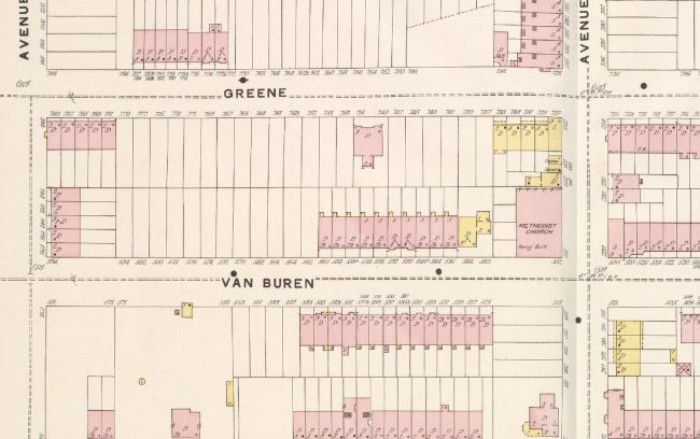
The reason is clear – at Lexington Avenue and Sumner Avenue (now Marcus Garvey Boulevard) the elevated railroad had a new station, which opened around 1888. Transportation always brings neighborhood growth, and within three years, most of the undeveloped lots in the neighborhood would be full.
The DeBevoise house was quite substantial, a 40-foot-wide cube of a house with three stories and a large rear extension. The style is Queen Anne, with a Second Empire tower on one end, which in its day had a handsome slate roof and perhaps some ironwork cresting as well.
Other interesting details include the arched window on the third floor, the interesting way the architect mixed up the bays — one rectangular, the other angled and three sided — and the terra cotta trim throughout. There was probably a good deal of stained glass here originally too, in the window transoms and perhaps on the side of the building and in the doorway.

The DeBevoise family lived here for a number of years. As Old Brooklyn aristocracy, they were automatic members of society, and the engagements and marriages of the DeBevoise children were duly noted in the papers.
Census data shows that Isaac DeBevoise was born in 1837. In 1900 he was 62 and married to Caroline, who was 59. Their son Charles was 28, and was a Manhattan stock broker. He lived here with his wife, Sarah, who was 25. Also in the home was another son, Cornelius, 24, and a widowed daughter, Magdalene DeBevoise Hinman, age 32.
Taking care of the family was a number of servants, perhaps all related. They were all African Americans from Virginia. Richard Smith, age 59; his son Richard F. Smith, age 21; James A. Farrat, age 29; and Maria E. Farrat, age 23.
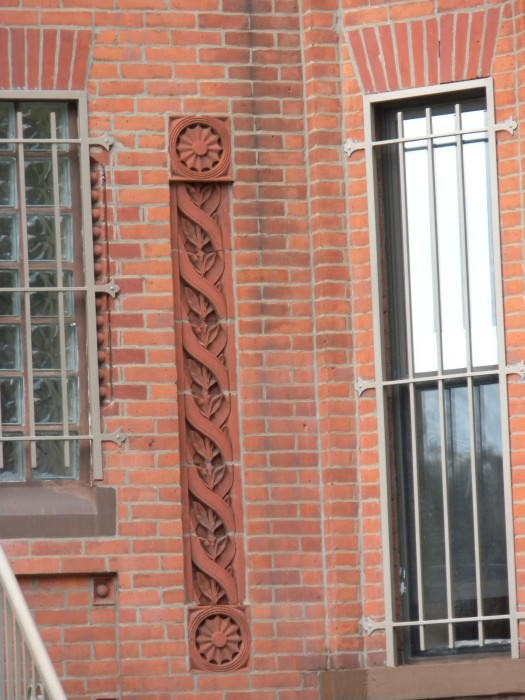
Charles DeBevoise would become the best known family member. He was a Yale man, who after graduating came back home for a career on Wall Street. He also joined Troop C of the New York State National Guard. By 1916, he was Commander of the 1st Cavalry NYSNG.
During World War I, he became a colonel, and after great heroics and leadership during several key battles in France, he was promoted to Brigadier General.
After the war, he and his wife moved to Carroll Street in Park Slope. As a note of interest, his wife, Sarah Pilcher, had a brother named Lewis F. Pilcher, who was an architect for the State of New York. One of his projects was the Troop C Armory at Bedford Avenue and Union Street, his brother-in-law’s original National Guard unit.
Isaac DeBevoise died in 1901. The family stayed on for a few more years, and then sold the house to a real estate dealer, B. F. Knowles. He didn’t hold on to it for long. Like many area mansions, this one became a club and gathering space. The papers refer to it as the Sigma Club in 1911. The trail goes cold after that; it probably became apartments a long time ago.

Today it is an eight-unit apartment building operating under an affordable housing program. It has been part of the Neighborhood Housing Partnership since 1997. Although many less than sympathetic changes have occurred, I’m glad it’s still here, pretty much intact, a reminder of this neighborhood’s long history.
Top photo: Suzanne Spellen
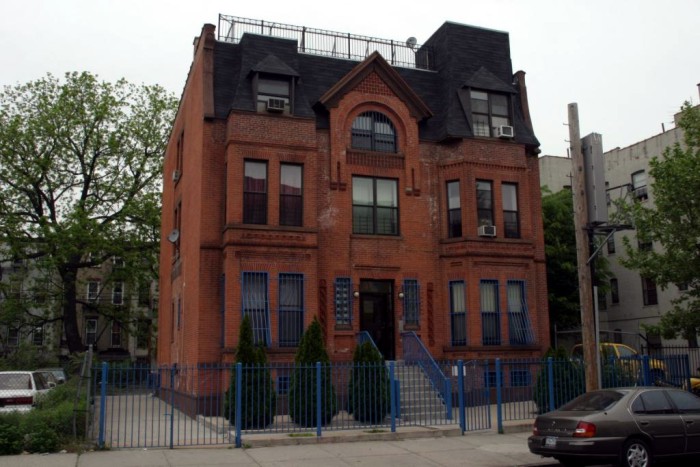

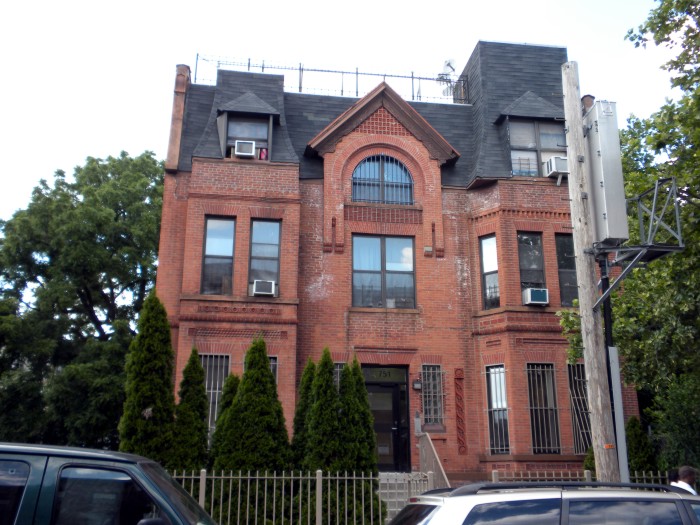





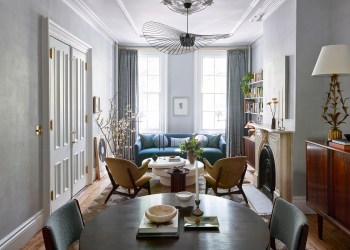


MM, while this is a bit off-topic, I am not sure where else to go.
In describing this building as situated in Brooklyn’s old Eastern District, you should note that what we now know as Bed-Sty was initially a portion of Brooklyn’s Western District, as it was part of the old City of Brooklyn that absorbed the Eastern District – Williamsburg, Bushwick and Greenpoint – in 1855. Yet by the end of the 19th century, a good portion of what we now know as Bed-Sty was apparently now somehow “annexed” to the Eastern District. How did this occur? Did it involve the fact that the eastern portion of Bedford was underpopulated until the late 1800’s and, when development did arrive, was then more associated with the communities to the east than to the older portions of Bedford? Or did the old Brooklyn/Bushwick boundary on Broadway just disappear as a significant factor after 1855 and the perception of what was east or west just move westward during this time? If so, how far did this functional border move? In other words, where was the old town of Bedford considered to be in the Western or Eastern District of Brooklyn?
While I realize these are very much arcane matters, I am – well- a pretty arcane person myself and am one of the few persons who find such things interesting. If you would like to pursue this item off-line, please contact me at my personal e-mail of jdereszewski@gmail.com.
In any event, I hope to hear from you on this – at least to me – interesting subject.